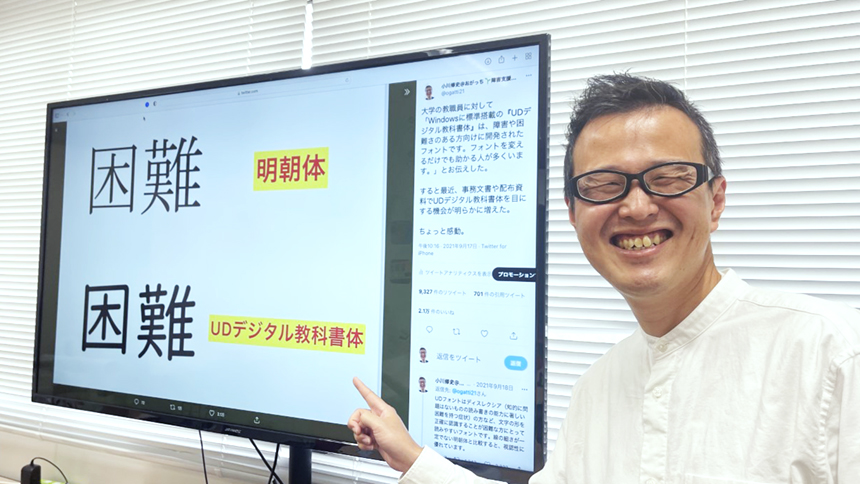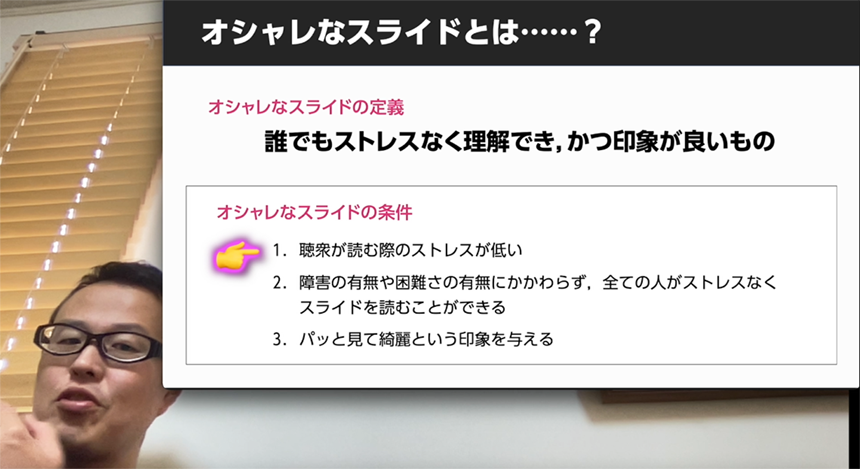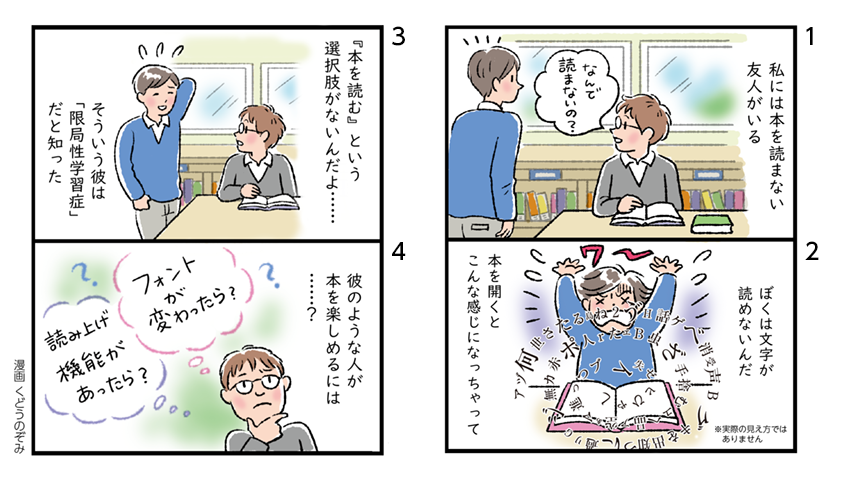
This is an interview series where we hear from people who are active in various fields and have their font switch turned on. This time, we interview Professor Osamu Ogawa of Hyogo University of Teacher Education, who is engaged in research on special needs education.
Professor Ogawa is always giving advice on creating materials to students and teachers at the University of Education. At the end of the article, you can watch a video lecture on creating materials using UD fonts, "How to Create Stylish Materials" (approximately 10 minutes), which compactly summarizes the professor's know-how. Please make use of it..
Interviewee:
Associate Professor Ogawa Shuji, Graduate School of Education, Hyogo University of Teacher Education, Life, Health and Information Education Course
Interviewer & Writer:
Hiromi Takada (UD Digital Textbook Font Developer) of Morisawa Inc.
Professor Ogawa's field and the use of UD fonts
MorisawaProfessor Ogawa, please tell us about your daily work.
Professor OgawaI am currently working in information education at the Graduate School of Education at Hyogo University of Teacher Education, and am also conducting research in the field of educational technology, primarily in the area of special needs education (intellectual disabilities and developmental disabilities).
Educational technology is an academic field whose basic concepts were established around the 1950s, but until now, the infrastructure was not in place and theory was seen as taking precedence. However, due to the impact of COVID-19, it seems that the infrastructure for practical implementation, such as the use of tablets in educational settings and online distance learning, has rapidly caught up over the past two years. For example, thanks to the efforts of teachers during the COVID-19 pandemic, the field is rapidly expanding, with the distribution of video content, the construction of original platforms, and the creation of digital teaching materials.
Among them, I am paying attention toICT use in special needs educationIntellectual and developmental disabilities are highly compatible with ICT, and there are many cases where children who have difficulty learning can access learning through the use of ICT. The use of ICT not only reduces the burden and stress associated with learning, but is also expected to create the joy of learning and motivation to come to school.
MorisawaIn terms of special needs education and ICT, what advice do you give to students and teachers at universities of education?
Professor Ogawa I often provide advice on the teaching materials and resources to be presented to children. From the perspective of special needs education, it is essential to create teaching materials that take into full consideration the difficulties that children experience.
How can we make teaching materials easy to see? Especially in the case of distance learning, if it is difficult to see, children will move away from the screen.Difficulty in seeing and understanding teaching materials is a fatal flawEven in the educational field, trial and error has begun to explore how to choose the right font and layout to make the text easier to understand.
In my university courses on information education, I also teach tips on creating teaching materials and the importance of font selection. For example, if slides are too narrow and packed with text, students will lose interest in reading and lose their motivation to learn, so it's important to keep the amount of information to a minimum and make it look neat.
*We asked Professor Ogawa to create a 10-minute video lecture on creating materials, "How to Create Stylish Materials," using Morisawa's UD fonts. You can watch it after filling out the form using the button at the end of the page.

Supporting motivation
MorisawaOn your social media accounts, you often talk about the importance of supporting motivation. What prompted you to start doing this?
Professor OgawaMy research topic is "I want to provide reasonable consideration and support for children's motivation." Until now, the trend has been to eliminate negativity by reducing problems and eliminating obstacles, but while that is important, I feel that it is not enough. In other words,We want to cherish the children's desire to "do it!" and their enthusiasm and motivation to "continue!"Children who are experiencing difficulties tend to have experiences where their efforts are not rewarded, making it difficult for them to develop motivation. This is why I think we need to provide more support to help them develop motivation and drive.
I used to work part-time at a Japanese restaurant. I tend to be very careless, so I made so many mistakes that the manager was planning to fire me.
The head chef at the time picked me up.
The chef took every precaution for me.
A kitchen timer for deep frying, a checklist for deep frying ingredients...continued
— Osamu Ogawa @Ogatti🌱Researcher who thinks about disability support from a 135-degree angle (@ogatti21) March 14, 2020
These thoughts prompted me to start posting on social media. I believe that in order to motivate children, they need "choices." It all started with a comment from an acquaintance of mine who has limited learning disorder. He said, "Even if I want to read a book, I can't read the letters. I don't have the option to read, so I can't enjoy books." I was shocked. I see... so he didn't have the "choices" that would motivate him...

I want to create "options" that inspire motivation, and I conduct research every day. In that sense, Morisawa's "UD Font" is truly a "option."Among them, the "UD Digital Textbook Font" has provided the option of "reading books" to people who were unable to "read" due to reasons such as limited learning disabilities or low vision.I am deeply grateful for that.
Children's reactions to UD digital textbook
MorisawaAs a developer, it is very encouraging to know that there are people who see it that way. I also hope that "UD Digital Textbook Font" will be seen as an "option" rather than a "multiple choice."
Professor Ogawa, please tell us how you first came across the UD Digital Textbook Font and how it is used in your everyday educational settings.
Professor OgawaI work in educational technology and special needs, so I heard rumors early on in the community that there was a font that was easy to read and easy to read, and I immediately purchased it. It was later included in Windows 10 and has spread rapidly in the educational field. The biggest benefit I felt was that it was not only functional, but also made documents look stylish. The other day, I tweeted an image of the "UD Digital Textbook Font" and it went viral (21,000 likes!), and the most common response was, "I liked this font and used it, but I didn't know it had such a history.","I used it because it was easy to read, but did the UD in the font name stand for Universal Design?" I think that the original idea is to use it naturally because it is easy to use, easy to read, stylish, cute, and that users like it, without any preconceived notions about universal design or textbook style.
We told the university faculty and staff, "The UD Digital Textbook Font that comes standard with Windows is a font developed for people with disabilities or other difficulties. Many people can benefit from simply changing the font."
Recently, there has been a clear increase in the number of opportunities to see UD digital textbook fonts in administrative documents and handouts.
I was a little moved. pic.twitter.com/9LZNxTvuoz
— Osamu Ogawa @Ogatti🌱Researcher who thinks about disability support from a 135-degree angle (@ogatti21) September 17, 2021
Now, I feel that "UD Digital Textbook Font" is spreading so rapidly that I see it in research meetings, student documents, and even on the streets. I think that this font has become a gateway for ordinary computer users in Japan to become interested in fonts and become more conscious of font selection, rather than just designers and other people who have been particular about fonts up until now.
MorisawaI believe that the reason this typeface has become known to so many people in the field of education is thanks to teachers like Mr. Ogawa who support and spread the word. Thank you!
How do the children react to the change in font?
Professor OgawaThe children also commented that "I can now read the letters on the blackboard more easily without glasses" and "I can now see the materials more easily and concentrate better."Children who experienced changes in readability due to fonts were able to request consideration (self-advocacy) from their teachers by saying, "I want the font changed!"I think this is a big change, and I feel that teachers are now more likely to be considerate of everyone, rather than just focusing on one special child, as a universal design.
MorisawaI'm very happy that children can now learn and request fonts that are easy for them to read, whatever the typeface. I hope that with the advancement of ICT, we will see an era where children can easily choose their favorite typefaces themselves, rather than having to ask a teacher. Even for the same person, I think that the typefaces they find easy to read will change depending on the situation and purpose, and the typefaces they will want to choose will also change.
Professor OgawaIf children are motivated, they will try to do it themselves, even if it is a little difficult! I want children to love fonts. What I hope for from Morisawa in the future is to increase the font selection even more and create an environment where children can enjoy choosing from a variety of fonts with excitement, just like enjoying fashion.
MorisawaAs I listened to Professor Ogawa's talk,oneIt is clear that the school consistently values the motivation and enthusiasm of the children, and its activities support the children's independent learning.I agree. I'm glad that Professor Ogawa himself understands the importance of fonts and loves them.
Thank you for the interview!
Mr. Ogawa is passionate about using ICT in special needs education. His comment that "difficulty in seeing and understanding teaching materials is a fatal flaw" left a strong impression on me.
Professor Ogawa's short lecture video, "How to Create Stylish Materials" (approximately 10 minutes), which summarizes his know-how, can be viewed after registering the form using the button below. Please make use of it in your field of work!
